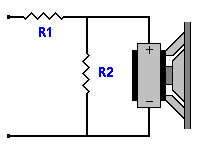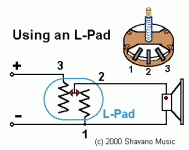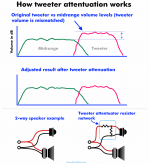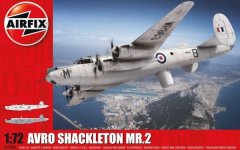Hi,
The harshness is immediate and stands out like a sore thumb. I cannot imagine getting used to it. It was this sort of harshness that made me sell my previous series of speakers (various makes) and revert to the Glendale 3XP.
Before I do anything I will put the old 4uf capacitors back and see what happens - if that is ok I will leave it like that for the time being as I can live with the mid and base as it is.
Hoping to get new hearing aids in the next few weeks (It can take a month or so from testing) and I will see how that affects the sound although I do have four adjustments on the present ones I use, one of which is for music!
Geoff.
The harshness is immediate and stands out like a sore thumb. I cannot imagine getting used to it. It was this sort of harshness that made me sell my previous series of speakers (various makes) and revert to the Glendale 3XP.
Before I do anything I will put the old 4uf capacitors back and see what happens - if that is ok I will leave it like that for the time being as I can live with the mid and base as it is.
Hoping to get new hearing aids in the next few weeks (It can take a month or so from testing) and I will see how that affects the sound although I do have four adjustments on the present ones I use, one of which is for music!
Geoff.
Geoff, the new 3.9 uF film capacitors should certainly have made the tweeters sound brighter.
Now, that may be too bright considering your jet fighter induced hearing loss and your need to listen to your Hi-Fi through hearing aids.
As an experiment, try disconnecting the tweeters completely, and report back on the difference this makes.
Now, that may be too bright considering your jet fighter induced hearing loss and your need to listen to your Hi-Fi through hearing aids.
As an experiment, try disconnecting the tweeters completely, and report back on the difference this makes.
Ok, done and to me it sounds a lot better.
The sound is slightly recessed compared to previously but certainly, to my damaged hearing, it is nicer to listen to and I don't wince when I am listening. It would seem that the midrange speaker also puts out a good bit of low treble.
All that is missing is the highest frequencies - violins, clarinets at high level etc - and I don't mind that. Even pianos sound quite good.
Strikes me that a switch to turn on and off the tweeter would be worth doing - fitted on the back so I have a choice although I will still put the old 4uf capacitor back - unless you have another suggestion for the tweeter.
Great help and thank you.
Geoff.
The sound is slightly recessed compared to previously but certainly, to my damaged hearing, it is nicer to listen to and I don't wince when I am listening. It would seem that the midrange speaker also puts out a good bit of low treble.
All that is missing is the highest frequencies - violins, clarinets at high level etc - and I don't mind that. Even pianos sound quite good.
Strikes me that a switch to turn on and off the tweeter would be worth doing - fitted on the back so I have a choice although I will still put the old 4uf capacitor back - unless you have another suggestion for the tweeter.
Great help and thank you.
Geoff.
See midrange's comment in post #26 - the midrange units will reproduce lower treble as well.
I know my hearing begins to drop off around 5kHz, so I'm not likely to hear a lot of what my tweeters are doing!
The way to adjust the level of the tweeter is not to alter the capacitor value - that would change the crossover frequency.
The tweeter can be attenuated using a pair of resistors arrange in an L-pad circuit (see attachment). This is placed between the high pass filter and the tweeter. I can suggest resistor values to try if you wish to pursue this course.
I know my hearing begins to drop off around 5kHz, so I'm not likely to hear a lot of what my tweeters are doing!
The way to adjust the level of the tweeter is not to alter the capacitor value - that would change the crossover frequency.
The tweeter can be attenuated using a pair of resistors arrange in an L-pad circuit (see attachment). This is placed between the high pass filter and the tweeter. I can suggest resistor values to try if you wish to pursue this course.
Attachments
Last edited:
If you were willing to mount a switch on the back of the enclosure, then you may wish to consider mounting a variable L pad control (see attachment).
This will allow you to adjust the treble up and down in level to suit your taste.
A major advantage of using a variable control is that we won't have to experiment with fixed resistor values.
Buy your 8 ohm L pads here: 8 Ohm L-Pad Attenuator -15 Watts - Willys-Hifi Ltd
This will allow you to adjust the treble up and down in level to suit your taste.
A major advantage of using a variable control is that we won't have to experiment with fixed resistor values.
Buy your 8 ohm L pads here: 8 Ohm L-Pad Attenuator -15 Watts - Willys-Hifi Ltd
Attachments
P.S. An L pad is not like an amplifier treble control that rolls off the higher frequencies more than the lower ones.
An L pad moves the entire treble frequency range up and down in a shelf like fashion as illustrated in the attachment.
An L pad moves the entire treble frequency range up and down in a shelf like fashion as illustrated in the attachment.
Attachments
Last edited:
Galu,
Good idea - I will go the L-Pad route.
Had this done a few years ago by Icon Audio when I bought an amp from them and they modified a pair of coffin like speakers I had (made in Scotland) for me. Used a screwdriver through the back to adjust but eventually the amp and the speakers were sold as I simply couldn't get used to them.
Must say that jet engines do ruin hearing but back in the 1960s ear covers were unheard of as the problem wasn't know then. Lightnings and Hunters were very loud and the high frequencies they put out was the unknown problem. Add old age hearing loss doesn't make it easy!
Will get back to you once something more has been done. Thanks again for you help.
Geoff.
Good idea - I will go the L-Pad route.
Had this done a few years ago by Icon Audio when I bought an amp from them and they modified a pair of coffin like speakers I had (made in Scotland) for me. Used a screwdriver through the back to adjust but eventually the amp and the speakers were sold as I simply couldn't get used to them.
Must say that jet engines do ruin hearing but back in the 1960s ear covers were unheard of as the problem wasn't know then. Lightnings and Hunters were very loud and the high frequencies they put out was the unknown problem. Add old age hearing loss doesn't make it easy!
Will get back to you once something more has been done. Thanks again for you help.
Geoff.
I built the Airfix models of the Hawker Hunter and E E Lightning in my teenage years - probably at the same time you were working on the real thing!
Versions are now included in the 75+ stash of model kits I've amassed since my retirement.
You've put me in the mood to assemble the Hunter - it has such beautiful lines.
Versions are now included in the 75+ stash of model kits I've amassed since my retirement.
You've put me in the mood to assemble the Hunter - it has such beautiful lines.
Last edited:
P.S. I would retain the new 3.9 uF film capacitor until after you've heard the effect of fitting the L pad.
The old ELCAP will spoil the quality of the treble with respect to clarity (as distinct from loudness).
The old ELCAP will spoil the quality of the treble with respect to clarity (as distinct from loudness).
Galu,
I worked on the Mk1a and Mk3 Lightnings of 56 Sqn and 111 Sqn both at RAF Wattisham and in Cyprus 1964 to 1966, then at RAF Gutersloh in Germany on Hawker Hunter FR10s 1966 to 1969. I was an RAF Photographer, so, besides normal photography I worked with the gun/missile cameras of the Lightnings and the Photo Recce cameras of the Hunters FR10 - I was actually posted to 2 then 4 Mobile Field Photographic Units at Gutersloh but that also involved working on the aircraft (the FR10 had 3 x F95 (70mm film) cameras in the nose for very low level recce work - 400mph 50 to 400 ft!).
Later I worked on Shackleton Mk2 at RAF Gan in the Maldives - mainly flying in them but also checking their cameras. Was a good time.
Since then as an MOD Professional Photographer I have flown in Hercs and many hours in Gazelle (jet engines again) helicopters doing air to ground photography - no wonder my hearing is a wreck although by then I was already wearing hearing aids and always wore a flying helmet when up in the clouds.
Lightning Mk3 model of 56 Sqn is available with their red white coloured fins - quickly removed by orders of the RAF. The Hunter FR10 model is only available in the USA for some unknown reason. Both the above are metal ready built only and I have both on display at home 1/72 scale.
Don't know if you have in your collection an unmade Russian model of the Lightning. I had one but gave it away to the very last RAF pilot to fly the aircraft (his father was one of the first as Commanding officer of 111 Sqn).
Ordered the L-Pads - now awaiting their arrival.
Question - if I replaced the new 3.9uf with the old 4uf one would the L-Pad still work with it - if I need to that is? Trial and error!
Regards,
Geoff.
I worked on the Mk1a and Mk3 Lightnings of 56 Sqn and 111 Sqn both at RAF Wattisham and in Cyprus 1964 to 1966, then at RAF Gutersloh in Germany on Hawker Hunter FR10s 1966 to 1969. I was an RAF Photographer, so, besides normal photography I worked with the gun/missile cameras of the Lightnings and the Photo Recce cameras of the Hunters FR10 - I was actually posted to 2 then 4 Mobile Field Photographic Units at Gutersloh but that also involved working on the aircraft (the FR10 had 3 x F95 (70mm film) cameras in the nose for very low level recce work - 400mph 50 to 400 ft!).
Later I worked on Shackleton Mk2 at RAF Gan in the Maldives - mainly flying in them but also checking their cameras. Was a good time.
Since then as an MOD Professional Photographer I have flown in Hercs and many hours in Gazelle (jet engines again) helicopters doing air to ground photography - no wonder my hearing is a wreck although by then I was already wearing hearing aids and always wore a flying helmet when up in the clouds.
Lightning Mk3 model of 56 Sqn is available with their red white coloured fins - quickly removed by orders of the RAF. The Hunter FR10 model is only available in the USA for some unknown reason. Both the above are metal ready built only and I have both on display at home 1/72 scale.
Don't know if you have in your collection an unmade Russian model of the Lightning. I had one but gave it away to the very last RAF pilot to fly the aircraft (his father was one of the first as Commanding officer of 111 Sqn).
Ordered the L-Pads - now awaiting their arrival.
Question - if I replaced the new 3.9uf with the old 4uf one would the L-Pad still work with it - if I need to that is? Trial and error!
Regards,
Geoff.
Dealing with the practical question, the operation of the L pad is independent of the capacitor value.
I'll get back re the rest of your interesting post soon!
I'll get back re the rest of your interesting post soon!
You must have read my mind, Geoff, as I was thinking how interesting it would be to learn of your career - and I wasn't wrong!
An RAF/MOD photographer - such an ace job! 😎
Thanks so much for taking your time to share your experiences with me/us.
I don't have a Russian model of a Lightning. If you're looking for a kit of an F3, then Trumpeter do one in 1/72 scale - stock number 01635.
Look at one of my latest charity shop finds!
An RAF/MOD photographer - such an ace job! 😎
Thanks so much for taking your time to share your experiences with me/us.
I don't have a Russian model of a Lightning. If you're looking for a kit of an F3, then Trumpeter do one in 1/72 scale - stock number 01635.
Look at one of my latest charity shop finds!
Attachments
Yes, it was interesting indeed - better than sitting at a desk doing admin which is what I originally was trained to do!
Lightning models - I have a 56 Sqn Mk3, 111 Sqn Mk 3, 56 Sqn Mk1a and also a brass Mk1a.
I also have the Hunter FR10 bought through E Bay from the USA and finally a metal model of a Gazelle. Must get a Shackleton MR2 sometime!
No doubt when I kick the bucket my kids will simply throw them in the bin!
The L Pads from Willy's are on the way - might even be here this week. At present, listening to the speakers without the tweeter connected - sounds quite good to me although I do find the bass is a bit less rounded with a sharper cut-off but then they are new bass units and will take some running in anyway. Might swop them for a pair of older ones I have to see if there is much sound difference.
Must put my pair of Wharfedale Glendale XP2s up for sale as well, as I don't need them now.
Geoff.
Lightning models - I have a 56 Sqn Mk3, 111 Sqn Mk 3, 56 Sqn Mk1a and also a brass Mk1a.
I also have the Hunter FR10 bought through E Bay from the USA and finally a metal model of a Gazelle. Must get a Shackleton MR2 sometime!
No doubt when I kick the bucket my kids will simply throw them in the bin!
The L Pads from Willy's are on the way - might even be here this week. At present, listening to the speakers without the tweeter connected - sounds quite good to me although I do find the bass is a bit less rounded with a sharper cut-off but then they are new bass units and will take some running in anyway. Might swop them for a pair of older ones I have to see if there is much sound difference.
Must put my pair of Wharfedale Glendale XP2s up for sale as well, as I don't need them now.
Geoff.
I noted your Shackleton MR2 model but I will look for a metal one first and see if they exist.
My hands, full of arthritis, will not let me make a model these days.
Geoff.
My hands, full of arthritis, will not let me make a model these days.
Geoff.
The newly tooled Airfix kits such as the Shackleton are highly detailed. I doubt if I could ever do it justice with my meagre modelling skills. Nice to have and admire, but it will probably end up back in the charity shop!
Regarding replacing those unreliable ELCAP capacitors - I would now expect the sound to be 'tighter' and more focused.
After doing a similar job on a friend's Wharfedale E50 speakers, he was at first uncertain of the new sound until he realised he no longer required to use his amplifier's loudness control to make up for deficiency in the bass.
Did you introduce the new bass drivers at the same time as upgrading the capacitors? That would introduce an additional variable to the mix, making the result less predictable.
Regarding replacing those unreliable ELCAP capacitors - I would now expect the sound to be 'tighter' and more focused.
After doing a similar job on a friend's Wharfedale E50 speakers, he was at first uncertain of the new sound until he realised he no longer required to use his amplifier's loudness control to make up for deficiency in the bass.
Did you introduce the new bass drivers at the same time as upgrading the capacitors? That would introduce an additional variable to the mix, making the result less predictable.
Hi,
Yes agreed, tighter and more focused though perhaps not as smooth but yes I did put the new base drivers in at the same time and realise it adds another variable but I can easily swop them for the "Used" ones as a trial to see what prefer. Probably leave them to wear in over a few weeks - trial and error until I get it right! - if ever.
Regards,
Geoff.
Yes agreed, tighter and more focused though perhaps not as smooth but yes I did put the new base drivers in at the same time and realise it adds another variable but I can easily swop them for the "Used" ones as a trial to see what prefer. Probably leave them to wear in over a few weeks - trial and error until I get it right! - if ever.
Regards,
Geoff.
Here's an addition which may have a noticeable effect on the bass response. It would be worth doing while you are fitting the L pad control.
I advised a 22 uF capacitor to replace the original 25 uF ELCAP which forms part of the bass driver filter (since 25 uF is no longer a standard value).
However, soldering a 3.3 uF capacitor in parallel (side by side) with the 22 uF would increase the capacitance to 25.3 uF.
I advised a 22 uF capacitor to replace the original 25 uF ELCAP which forms part of the bass driver filter (since 25 uF is no longer a standard value).
However, soldering a 3.3 uF capacitor in parallel (side by side) with the 22 uF would increase the capacitance to 25.3 uF.
- Home
- Loudspeakers
- Multi-Way
- Wharfedale speaker 3XP and XP2 tweeters



